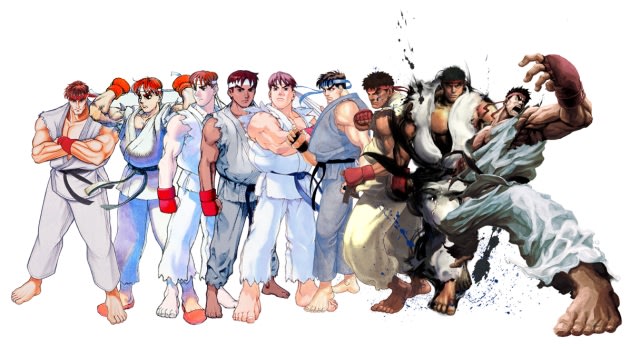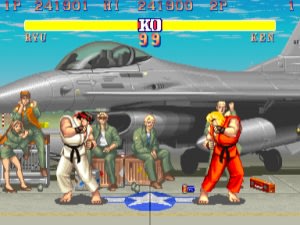
(Credit: Capcom)The most famous fighter in video game history might be a little old, but it still packs a wallop.
The most famous fighter in video game history might be a little old, but it still packs a wallop - And lots of Hadoukens. Believe it or not, Capcom's legendary Street Fighter turns 25 today. While it wasn't the first fighting game ever made (that honor arguably goes to the 1976 coin-op Heavyweight Champ), Street Fighter indelibly altered the genre with its intuitive controls, fantastic animations and deep gameplay. It's had an equally large impact on popular culture, spinning off into movies, cartoons, and even a fancy slot machine.
The secret to its success? To Russ Frushtick, senior editor of video game site Polygon, it's all about balance.
"[The Street Fighter series] has stood the test of the time because it's both accessible and extremely strategic," he says. "If you know nothing about the game and just want to jump around, kicking guys in the face as a green monster, Street Fighter will let you live out that fantasy. For the more serious players, there's a staggering amount of depth."
He's right about that. The Street Fighter franchise been a pro gaming staple for decades. Since 2002, it's dominated the popular EVO tournament, which gives thousands of players from over 40 countries a chance to prove their mettle in a variety of fighting games. Year after year, Street Fighter is the star of the show.
"It's a game that could take years to master," Frushtick adds. "Basically, it's this generation's chess."
And indeed, it owes a great deal to its legions of fans.
"The greatest legacy that Capcom has generated with the Street Fighter franchise is the company's unbelievable loyalty and availability to its fans," says Victor Lucas, host and executive producer of The Electric Playground. "Fighting games are a community-driven activity, and upon their arrival -- and Street Fighter's global ascension as the best of the breed -- they instantly dispelled the myth that gaming was a solitary affair, singularly enjoyed by pubescent boys in basements."
"The universally appealing, international roster of fighters that Street Fighter II delivered, its unparalleled level of depth, its state-of-the-art art and, of course, its quarter-gobbling addictiveness, instantly propelled the game to classic status, where it has remained ever since."
But it wasn't always such a big deal.
Released in arcades in 1987, the original Street Fighter was only a marginal hit. No one was quite sure what to make of it, and while it introduced plenty of elements that would turn into franchise staples (Ryu and Ken, six-button controls and those now-ubiquitous Hadoukens and Dragon Punches), it was more of a curiosity than a must-play. That was especially true of the Deluxe version, which featured two pressure-sensitive pads in place of the six buttons. The harder you punched the pads, the harder your character would attack in the game (and the faster the coin-cop cabinet would be rendered inoperable).

Street Fighter II (Credit: Capcom)That short-lived gimmick was quickly forgotten, however, the moment Street Fighter II tornado kicked its way to arcades. The 1991 coin-op was an instant classic, generating over $1 billion in sales during its first year thanks to its brilliantly balanced roster of now-iconic fighters. The first game to let players pick different fighters with completely unique move sets, it's the blueprint for every major fighting game franchise that's followed.
But it was also its own worst enemy. Sensing a turning tide, Capcom ported the coin-op game to the Super Nintendo system in late 1992. Its near-flawless transition made the console game a huge hit -- it remains Capcom's best-selling game ever -- but also struck a serious blow to coin-op culture by proving that these games could, in fact, work just as well at home.
Capcom continued releasing a variety of tweaked iterations of Street Fighter II through the '90s, catering to the hardcore fighting game crowd but losing touch with the broader gaming market. By the time they released Street Fighter III in 1997, graphical powerhouses like Virtua Fighter and Tekken were pushing polygons and leaving the 2D look of Street Fighter behind. For a good decade, the series would fall off the radar.
In 2009, however, it stormed back. Street Fighter IV not only gave the series back its mojo, but revived a fighting game genre that had become increasingly isolated. Slick, brash and tailored for both fans of the series and newcomers alike, it kicked off a fighting-game renaissance that's still going strong. Its next act, the PlayStation Vita version of the excellent Street Fighter X Tekken, arrives this October. Capcom's also celebrating its special year in grand style with a very cool 25th Anniversary Collector's Set.
Think you know Street Fighter? Capcom shared a few odd Street Fighter facts with Yahoo! Games. Did you know: It launched the career of a Mega Man.
Not Capcom's blue robot boy, per se, but his creator, Keiji Inafune. The acclaimed developer's first gig was designing the character portraits for the first Street Fighter.
Those names aren't entirely random.
It's pretty obvious that each Street Fighter character has a certain fighting style, but how did they come up with those names? Capcom let us in on a few:
- Series foil Akuma was originally named Gouki ("Great Demon" in Japanese), but his name was changed for U.S. audiences as the Capcom USA team wanted to present him as an actual demon rather than a metaphorical one. So they went with Akuma (Japanese for "Devil"). Hard to say how many Americans would have noticed the difference, but they get points for trying.
- Chun-Li means "Spring Beauty."
- Ken's last name is Masters, derived from his 'mastery' of the fighting arts.
It's got character. Lots of 'em.
Though the original Street Fighter had only a dozen characters (including Ryu and Ken), the designers have worked overtime cranking out new ones. Taken together, there are over 66 playable characters in the Street Fighter universe.
It marked Raul Julia's final film appearance.
Yes, the 1994 Street Fighter movie was a train wreck, but it had one very bright spot: Raul Julia. The acclaimed actor was praised for his portrayal of Street Fighter antagonist General M. Bison, even nabbing a posthumous Saturn Award nomination.
It produced the most epic comeback in pro gaming history.
Speaking of drama, it doesn't get much better than Daigo Umehara's astonishing series of exquisitely-timed parries to rally and defeat his Chun-Li playing opponent Justin Wong at the 2004 Evolution Championship Series. It's about as clutch as pro gaming gets: ( Plugged In )
No comments:
Post a Comment